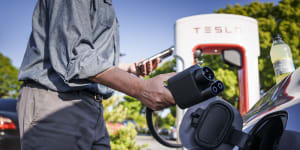The share of EVs in new car sales has tripled every year for the past three years as the number of models available in Australia rises and retail prices fall.

As EV sales take off,vital charging stations are also mushrooming.Philip Pacheco/Bloomberg
Meanwhile,the number of crucial EV charging stations is also growing rapidly – up 72 per cent in the past year,with 800 stations housing 2000 fast plugs around the country.
Climate Change and Energy Minister Chris Bowen said motorists and businesses were “moving with their wallets” to EVs.
“Just like we saw exponential growth in rooftop solar when choice increased and costs dropped,we’re starting to see that uptick in EVs and hybrids,which means cheaper running costs for households and businesses,” Bowen said.
The average EV costs around $400 in electricity per year,while annual fuel costs for a petrol car average $2400.
“More and more households and businesses are saving thousands of dollars on the upfront and running costs of their vehicles – with our EV discount making leasing EVs and plug-in hybrids cheaper than leasing petrol vehicles in many circumstances,” Bowen said.
Australia still lags the global market,where of new car sales in the past year. But the local market is catching up and EVs have grown rapidly to exceed 8 per cent of new cars sold in 2023,up from just 3 per cent in 2022.

Tax discounts can make a Tesla Model 3,retailing for around $62,000,cheaper to lease per month than petrol vehicles like the Mazda 3 Astina,which sells for up to $42,000.
With the average lifespan of a passenger car in Australia being 10 years,market analyst Bloomberg New Energy Finance said EVs would need to reach 100 per cent of new car sales by 2033 for the transport sector to achieve net zero emissions by 2050.

The government’s own Intergenerational Report,released in August,forecast that without a major policy intervention,.
However,Bloomberg New Energy Finance’s head of research Kobad Bhavnagri said while EV sales were currently on track to reach 50 per cent of new car sales by 2033,Australia could “absolutely” close the gap with reforms to boost their uptake.
“A fuel efficiency standard is key. It is one of the most economically efficient and scalable ways to increase adoption,” Bhavnagri said. “When policy support is introduced,you see the uptake rapidly increase and model availability increase.”
limit average emissions,measured in grams of CO2 per kilometre,produced by the overall fleet of vehicles sold into the market by a manufacturer to encourage them to sell more EVs.
Australia is one of the few global industrialised countries not to have one,and the government is running late on its pledge to release an impact analysis showing the options under consideration by the end of the year.
That outline is now expected next year. But even without it,Electric Vehicle Council chief executive Behyad Jafari said EV sales have doubled every year for the past three years,gaining market share in less affluent areas as prices fall.
Early figures indicate that in the past year,the majority of EV sales occurred outside of major cities’ inner suburbs.
“The areas where people are buying electric vehicles has really changed in the last few years,with the largest areas of uptake in the outer suburbs,particularly around western Sydney,” Jafari said.
Cut through the noise of federal politics with news,views and expert analysis from Jacqueline Maley. Subscribers can sign up to our weekly Inside Politics newsletter.